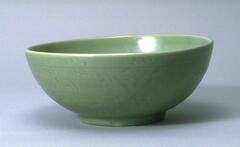44 UMMA Objects
44 UMMA Objects
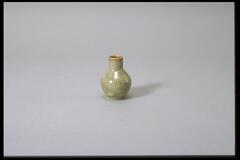
Seifū Yohei III
Narrow-necked vase with crackled celadon glaze
1880 – 1914
Bequest of Margaret Watson Parker
1954/1.510
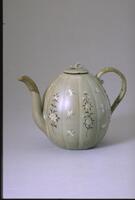
Korean (Korean (culture or style))
Ewer in the shape of a melon with inlaid floral and butterfly designs
1100 – 1150
Gift of Mrs. Caroline I. Plumer for the James Marshall Plumer Collection
1973/2.33
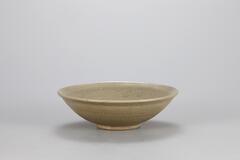
Chinese (Chinese (culture or style))
Bowl
11th century
Gift of Mr. Jennis R. Galloway through the Friends of the Museum of Art
1972/1.154
![<p>This bowl has a narrow foot and a ared mouth. is type of bowl was produced in large quantities from the 11th century to the 12th century. Its inner wall has mold-impressed peony sprays. The entire body of the bowl is glazed, including the inside of the foot, but the glaze on its rim of the foot was wiped away, on which refractory spurs were adhered to for ring. Parts of the inner surface show ne crackles, while the inner bottom was stained with greenish-brown iron spots. One part of the rim was damaged and subsequently repaired. Glaze applied to the outer surface has partially owed downwards, resulting in an uneven surface, but the glaze and clay are quite well fused and sintered.<br />
[<em>Korean Collection, University of Michigan Museum of Art</em> (2014) p.93]</p>
<br />
The celadon bowl has straight-lined sides. The surface is evenly coated with a dark bluish green glaze. The celadon bowl rests on a rather tall foot, which was hollowed out from the bottom. The designs are present only on the inside <p>This bowl has a narrow foot and a ared mouth. is type of bowl was produced in large quantities from the 11th century to the 12th century. Its inner wall has mold-impressed peony sprays. The entire body of the bowl is glazed, including the inside of the foot, but the glaze on its rim of the foot was wiped away, on which refractory spurs were adhered to for ring. Parts of the inner surface show ne crackles, while the inner bottom was stained with greenish-brown iron spots. One part of the rim was damaged and subsequently repaired. Glaze applied to the outer surface has partially owed downwards, resulting in an uneven surface, but the glaze and clay are quite well fused and sintered.<br />
[<em>Korean Collection, University of Michigan Museum of Art</em> (2014) p.93]</p>
<br />
The celadon bowl has straight-lined sides. The surface is evenly coated with a dark bluish green glaze. The celadon bowl rests on a rather tall foot, which was hollowed out from the bottom. The designs are present only on the inside](/media/W1siZiIsIjIwMjIvMDkvMjQvOWpqdXU4d2plel9kZWZhdWx0LmpwZyJdLFsicCIsInRodW1iIiwiMjQweDIwMCJdXQ?sha=d6b4e1202cb44ca4)
Korean (Korean (culture or style))
Conical bowl with molded floral design
12th century
Gift of Bruce and Inta Hasenkamp and Museum purchase made possible by Elder and Mrs. Sang-Yong Nam
2004/1.222
![<p>This celadon bowl is undecorated. The glaze is poorly fused and is generally opaque. The foot is low and displays traces of sand supports. The sand, stuck to the foot and the outer base, suggests that the bowl was placed on the kiln floor during ring. Glaze had run down to the outer wall of the foot and accumulated, in parts.<br />
[<em>Korean Collection, University of Michigan Museum of Art</em> (2014) p.97]</p>
<br />
shallow bowl, grey color, sanf grit on foot, made in Boryung kiln of ching chung nam-do, often found in tombs in Kangwa Island, 13th century, diameter 6+13/16 inches, height: 1+7/8 inches <p>This celadon bowl is undecorated. The glaze is poorly fused and is generally opaque. The foot is low and displays traces of sand supports. The sand, stuck to the foot and the outer base, suggests that the bowl was placed on the kiln floor during ring. Glaze had run down to the outer wall of the foot and accumulated, in parts.<br />
[<em>Korean Collection, University of Michigan Museum of Art</em> (2014) p.97]</p>
<br />
shallow bowl, grey color, sanf grit on foot, made in Boryung kiln of ching chung nam-do, often found in tombs in Kangwa Island, 13th century, diameter 6+13/16 inches, height: 1+7/8 inches](/media/W1siZiIsIjIwMjIvMDkvMjQvOHE1b3plcHhsc19kZWZhdWx0LmpwZyJdLFsicCIsInRodW1iIiwiMjQweDIwMCJdXQ?sha=c943e4400629e91b)
Korean (Korean (culture or style))
Kanghwa Bowl
12th century
Gift of Bruce and Inta Hasenkamp and Museum purchase made possible by Elder and Mrs. Sang-Yong Nam
2004/1.212
![<p>The cup has a mouth that curves slightly inwards; this is a form typical of round cups with saucers produced in large numbers in the 13th and 14th centuries. The cup is decorated only on the outer rim with a fret-patterned band. Repaired damage is visible on several parts on the mouth, as well as cracking that occurred during ring. Glaze has been applied down to the foot, and three quartzite spur marks remain on the outer base. The partially oxidized body displays darker patches on the surface, but it preserves a bright celadon color overall.<br />
[<em>Korean Collection, University of Michigan Museum of Art </em>(2014) p.120]</p>
The celadon cup has a mildly inverted rim with curved sides that are bent once, at a sharp angle, near the base. The surface is coated with a greenish blue glaze. The slightly inward-turning mouth facilitates drinking while the sides curve gently toward the base. <p>The cup has a mouth that curves slightly inwards; this is a form typical of round cups with saucers produced in large numbers in the 13th and 14th centuries. The cup is decorated only on the outer rim with a fret-patterned band. Repaired damage is visible on several parts on the mouth, as well as cracking that occurred during ring. Glaze has been applied down to the foot, and three quartzite spur marks remain on the outer base. The partially oxidized body displays darker patches on the surface, but it preserves a bright celadon color overall.<br />
[<em>Korean Collection, University of Michigan Museum of Art </em>(2014) p.120]</p>
The celadon cup has a mildly inverted rim with curved sides that are bent once, at a sharp angle, near the base. The surface is coated with a greenish blue glaze. The slightly inward-turning mouth facilitates drinking while the sides curve gently toward the base.](/media/W1siZiIsIjIwMjIvMDkvMjQvMmRjZTRvbXNlel9kZWZhdWx0LmpwZyJdLFsicCIsInRodW1iIiwiMjQweDIwMCJdXQ?sha=b6f3e998b597b135)
Korean (Korean (culture or style))
Wine cup with incised patterns
1100 – 1299
Gift of Bruce and Inta Hasenkamp and Museum purchase made possible by Elder and Mrs. Sang-Yong Nam
2004/1.225
![A yellow brownish glaze is applied and crackling covers the entire body.<br />
This bowl has straight wall. The exterior is carved with lotus petals. The below of the mouth is decorated with fret design. The foot is a little low.
<p>This is a cylindrical cup decorated with incised and raised design of lotus petals on the entire outer walls and is fretted on the outer rim. Overall, the cup is yellow-green in color and has three refractory spur marks. Many of the shards, excavated from sediment in the vicinity of Kiln no. 12 at Yucheon-ri, Buan-gun, Jeollabuk-do, are also those of cylindrical cups similar in form to this one.<br />
[<em>Korean Collection, University of Michigan Museum of Art </em>(2014) p.123]<br />
</p>
A yellow brownish glaze is applied and crackling covers the entire body.<br />
This bowl has straight wall. The exterior is carved with lotus petals. The below of the mouth is decorated with fret design. The foot is a little low.
<p>This is a cylindrical cup decorated with incised and raised design of lotus petals on the entire outer walls and is fretted on the outer rim. Overall, the cup is yellow-green in color and has three refractory spur marks. Many of the shards, excavated from sediment in the vicinity of Kiln no. 12 at Yucheon-ri, Buan-gun, Jeollabuk-do, are also those of cylindrical cups similar in form to this one.<br />
[<em>Korean Collection, University of Michigan Museum of Art </em>(2014) p.123]<br />
</p>](/media/W1siZiIsIjIwMjIvMDkvMjQvNWU0NDFuZ3Nuc19kZWZhdWx0LmpwZyJdLFsicCIsInRodW1iIiwiMjQweDIwMCJdXQ?sha=243d2e8e37f3b830)
Korean (Korean (culture or style))
Deep bowl with vertical sides and carved lotus petal design
1200 – 1399
Gift of Bruce and Inta Hasenkamp and Museum purchase made possible by Elder and Mrs. Sang-Yong Nam
2004/1.228
![<p>This type of bowls was produced in the 12th century when the production of celadon was increased. is piece is assumed to be a product of a kiln in Sadang-ri, Gangjin-gun, Jeollanam-do. e outer wall is decorated with incised and raised deisgn of a two- tiered lotus petal. The bowl was entirely glazed including the rim of the foot. e outer base retains three white quartzite spur marks. e glaze is fused well, displaying a ne gloss, but parts of it have been oxidized to tinge the inner surface with yellow.<br />
[<em>Korean Collection, University of Michigan Museum of Art </em>(2014) p.102]</p>
<p>This type of bowls was produced in the 12th century when the production of celadon was increased. is piece is assumed to be a product of a kiln in Sadang-ri, Gangjin-gun, Jeollanam-do. e outer wall is decorated with incised and raised deisgn of a two- tiered lotus petal. The bowl was entirely glazed including the rim of the foot. e outer base retains three white quartzite spur marks. e glaze is fused well, displaying a ne gloss, but parts of it have been oxidized to tinge the inner surface with yellow.<br />
[<em>Korean Collection, University of Michigan Museum of Art </em>(2014) p.102]</p>](/media/W1siZiIsIjIwMjIvMDkvMjQvOWVvOXU2emZncV9kZWZhdWx0LmpwZyJdLFsicCIsInRodW1iIiwiMjQweDIwMCJdXQ?sha=413a02bc2a8a0993)
Korean (Korean (culture or style))
Bowl with carved lotus design
12th century
Gift of Bruce and Inta Hasenkamp and Museum purchase made possible by Elder and Mrs. Sang-Yong Nam
2004/1.231
![It has a flared mouth. The side is tapering gently down to the base. It was brushed with white slip interior and outerior sides.<br />
<br />
Bowls of this kind were commonly used as burial accessories in the 15th century Joseon; many have been excavated. This bowl has been rapidly spun and brush-painted with white slip on its inner and outer surfaces. The large amount of sand mixed with the clay has produced a rough texture. Traces of clay supports remain on both the inner base and the rim of foot, indicating that this bowl was stacked among other bowls while separated by clay spurs during firing. The glaze was fused well, producing a glossy surface.<br />
[Korean Collection, University of Michigan Museum of Art (2014) p.155] It has a flared mouth. The side is tapering gently down to the base. It was brushed with white slip interior and outerior sides.<br />
<br />
Bowls of this kind were commonly used as burial accessories in the 15th century Joseon; many have been excavated. This bowl has been rapidly spun and brush-painted with white slip on its inner and outer surfaces. The large amount of sand mixed with the clay has produced a rough texture. Traces of clay supports remain on both the inner base and the rim of foot, indicating that this bowl was stacked among other bowls while separated by clay spurs during firing. The glaze was fused well, producing a glossy surface.<br />
[Korean Collection, University of Michigan Museum of Art (2014) p.155]](/media/W1siZiIsIjIwMjIvMDUvMjUvN2wwZnA4dXE4NV9kZWZhdWx0LmpwZyJdLFsicCIsInRodW1iIiwiMjQweDIwMCJdXQ?sha=8feb467e9a78db04)
Korean (Korean (culture or style))
Buncheong ware bowl with brushed 'hakame' design
16th century
Transfer from the College of Architecture and Design
1972/2.76
Loading…
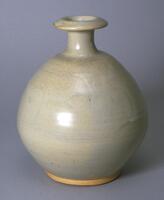
![<p>The bowl has a low, narrow foot, and diagonally aring out sides. It is decorated with raised designs on the inner wall, but they are so low relief that it is di cult to recognize what they are. The outer base retains three quartzite spur marks. Damage to a side of the mouth rim and the center of the bowl has been repaired.<br />
[<em>Korean Collection, University of Michigan Museum of Art </em>(2014) p.99]</p>
It flares out widely at the rim, then back in. Its sides, otherwise almost straight, taper to the base. There is no decorated. <p>The bowl has a low, narrow foot, and diagonally aring out sides. It is decorated with raised designs on the inner wall, but they are so low relief that it is di cult to recognize what they are. The outer base retains three quartzite spur marks. Damage to a side of the mouth rim and the center of the bowl has been repaired.<br />
[<em>Korean Collection, University of Michigan Museum of Art </em>(2014) p.99]</p>
It flares out widely at the rim, then back in. Its sides, otherwise almost straight, taper to the base. There is no decorated.](/media/W1siZiIsIjIwMjIvMDUvMjUvN2U2NG9zYmNkcV9kZWZhdWx0LmpwZyJdLFsicCIsInRodW1iIiwiMjQweDIwMCJdXQ?sha=ae9f35d738cbac9f)
